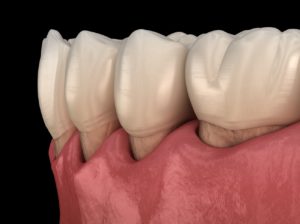 In regards to oral health, people tend to focus on their teeth alone. But your gums are very important as well because they give your teeth their strength and support. They also cover and protect the roots, which are otherwise very sensitive if they’re exposed. Unfortunately, receding gums are quite common and often lead to sensitivity and other dental problems. In this blog, you’ll learn about the various causes of gum recession, whether the gums can “grow back” on their own, and what your treatment options are. Find out more below!
In regards to oral health, people tend to focus on their teeth alone. But your gums are very important as well because they give your teeth their strength and support. They also cover and protect the roots, which are otherwise very sensitive if they’re exposed. Unfortunately, receding gums are quite common and often lead to sensitivity and other dental problems. In this blog, you’ll learn about the various causes of gum recession, whether the gums can “grow back” on their own, and what your treatment options are. Find out more below!
What Causes Receding Gums?
- Genetics – If receding gums run in your family, you’ll be more likely to experience it as well.
- Brushing too hard – It may seem like brushing harder is the best technique, but it actually does more harm than good and contributes to recession.
- Clenching and grinding – Also called bruxism, this common nighttime habit not only contributes to gum recession but also puts the teeth at risk for cracks and fractures.
Do the Gums “Grow Back?”
Unfortunately, no. If a dentist finds mild gum recession during a checkup, they’ll help you prevent it from getting worse and also treat any root sensitivity. To do this, they may demonstrate how to brush correctly or possibly recommend an electric toothbrush. When used correctly, electric toothbrushes apply far less pressure than manuals. They also do a better job at cleaning your teeth.
If necessary, a dentist may recommend a custom-made nightguard to protect both your teeth and gums from the chronic forces of clenching and grinding.
To address root sensitivity, they may recommend using a sensitivity formula toothpaste or extra topical fluoride from an in-office fluoride treatment or a prescription toothpaste at home. These options work by putting a protective coating over the roots to prevent heat, cold, or pressure from reaching the nerves of your teeth.
When recession is more severe, there are treatments that restore the gumline and allow the gums to function properly once again.
How Are Receding Gums Treated?
During your checkups, dentists use an instrument that resembles a tiny ruler to measure how much recession you have (in millimeters). If necessary, they’ll refer you to a specialist for a procedure called gum grafting to return your gums to their initial position. This is done by placing tissue from another area over the exposed roots and stitching it into place, essentially replacing the gum tissue that’s been lost.
Ultimately, receding gums are not only uncomfortable but also put your oral health at risk. With help from a dentist, you can keep your gums healthy and avoid any potential problems altogether.
About the Author
Dr. Shekhadiya has been practicing as a family dentist for over a decade and graduated from the New York University College of Dentistry. With an understanding of how important healthy gums are, he focuses on preventing gum recession as much as possible. If you’d like to know more about receding gums or have any questions, he can be reached via his website.
